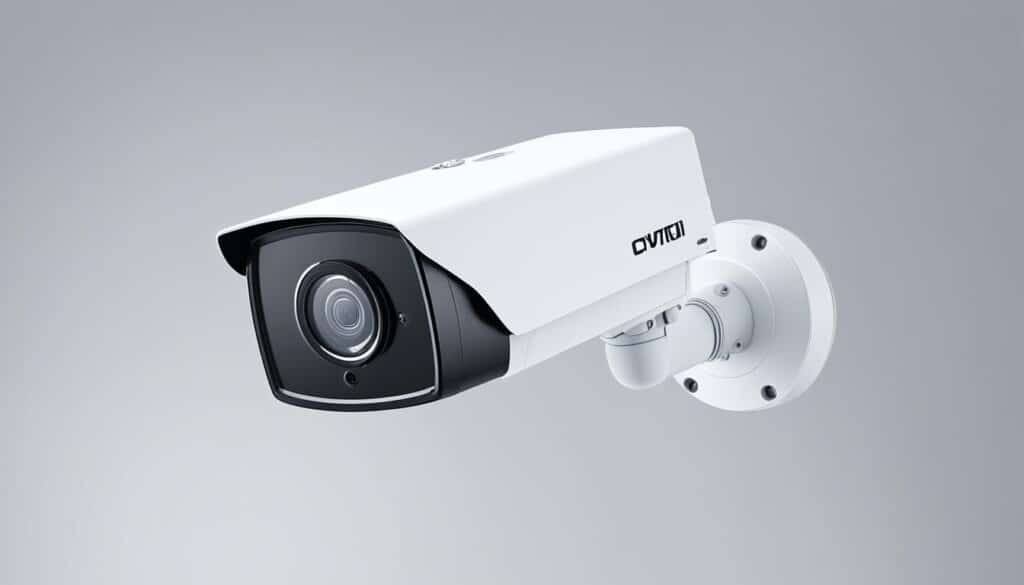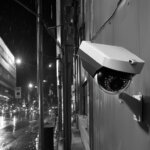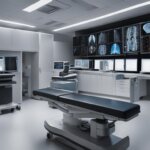Table of Contents
CCTV, also known as closed-circuit television, is a TV system that plays a crucial role in security surveillance. It utilizes strategically placed cameras to capture video footage, which is then transmitted to monitors or video recorders.
CCTV has a wide range of applications, from maintaining perimeter security in high-secure areas to observing behavior in medical facilities and monitoring traffic. It is also used for overseeing hazardous environments, ensuring building and grounds security, and obtaining visual records for security purposes. As technology advances, CCTV is increasingly being used in law enforcement as well.
However, it’s worth noting that the use of CCTV has raised privacy concerns in certain parts of the world, particularly in the UK and Europe.
With the growing need for enhanced security measures, understanding CCTV and its functionality is essential. In the following sections, we will delve deeper into how CCTV works, its various use cases, different camera types, recording systems, and important considerations in implementing CCTV technology.
How does CCTV work?
CCTV works by using surveillance cameras that capture video footage. These cameras are strategically placed to cover the desired areas. The cameras transmit their video feed to monitors or video recorders through private coaxial cable runs or wireless communication links. This closed-circuit setup ensures that access to the video content is limited to those who are authorized to view it.
The video can be viewed in real-time on monitors, and it can also be recorded for later review. Modern CCTV systems have advanced features such as color displays, high-resolution images, zoom capabilities, and the ability to track objects or people. Some CCTV systems also include audio capabilities, allowing the overseer to speak to individuals within the camera’s range.
Key Features of CCTV Systems:
- Surveillance cameras capture video footage.
- Cameras transmit video feeds to monitors or video recorders.
- Video content is limited to authorized viewers.
- Real-time viewing and recording for later review.
- Advanced features like color displays, high-resolution images, zoom, and object tracking.
- Audio capabilities for communication.
By combining surveillance cameras, monitoring systems, and recording capabilities, CCTV provides a comprehensive solution for security and surveillance needs. It allows for the monitoring of specific areas, the deterrence of criminal activity, and the collection of evidence for investigations.
Now let’s take a closer look at some popular CCTV use cases in Section 3.
CCTV Use Cases
CCTV (closed-circuit television) has become widely used across various industries and sectors for security surveillance applications. From maintaining perimeter security to monitoring traffic and supporting law enforcement, CCTV offers valuable solutions in different contexts.
Government Buildings, Airports, and Industrial Facilities
CCTV plays a crucial role in maintaining security in medium to high-secure areas, including government buildings, airports, and industrial facilities. By strategically placing cameras, security personnel can monitor the premises and quickly respond to any suspicious activity. CCTV surveillance helps deter criminal behavior and provides valuable evidence in case of incidents.
Medical Facilities
In medical facilities, CCTV serves important purposes such as observing the behavior of incarcerated inmates and monitoring potentially dangerous patients. By maintaining constant surveillance, staff can prevent security breaches and ensure a safe environment for both patients and medical professionals.
Traffic Monitoring and Enforcement
CCTV plays a vital role in traffic monitoring, helping authorities manage traffic flow and enforce traffic regulations. With strategically placed cameras, traffic incidents can be quickly detected and responded to, improving road safety and reducing congestion. CCTV footage also provides valuable evidence for traffic violations, allowing for automated ticketing and accurate monitoring.
Hazardous Environments
In locations that are hazardous for humans, such as highly radioactive or toxic industrial environments, CCTV becomes a critical tool for surveillance and safety. By using cameras to monitor these areas, personnel can avoid unnecessary exposure to dangers and respond promptly to any emergencies.
Building and Grounds Security
CCTV plays an essential role in maintaining building and grounds security. By providing a visual record of activities, CCTV helps ensure access control and prevents unauthorized entry. It also serves as a deterrent for potential criminal activity and provides valuable evidence when investigations are required.
Law Enforcement
In recent years, CCTV has become increasingly important in law enforcement. It aids in various law enforcement tasks, such as traffic observation, automated ticketing, and monitoring high-crime areas or neighborhoods. By leveraging CCTV technology, law enforcement agencies can enhance public safety, gather evidence, and support investigations.
| Industry/Sector | Use Case |
|---|---|
| Government Buildings | Maintaining perimeter security and deterring criminal behavior |
| Airports | Monitoring airports and ensuring passenger safety |
| Industrial Facilities | Enhancing security and preventing unauthorized access |
| Medical Facilities | Observing incarcerated inmates and monitoring potentially dangerous patients |
| Traffic Monitoring | Managing traffic flow, enforcing regulations, and detecting incidents |
| Hazardous Environments | Surveillance and safety in highly radioactive or toxic areas |
| Building and Grounds Security | Preventing unauthorized access and providing evidence of activities |
| Law Enforcement | Traffic observation, automated ticketing, and monitoring high-crime areas |
Understanding CCTV Camera Types
When it comes to CCTV systems, there are different camera types to consider, each with its own advantages and applications. The two main types are IP (Internet Protocol) cameras and analog cameras.
IP Cameras:
IP cameras are widely preferred due to their compatibility with most applications. They offer higher resolution and can be easily integrated into digital systems, making them suitable for modern surveillance setups. IP cameras capture high-quality video footage, providing clear and detailed images. They also offer advanced features such as remote access and video analytics, enhancing the overall security capabilities of the system.
Analog Cameras:
Analog cameras, on the other hand, are best suited for legacy digital recording systems with older technology. These cameras have been widely used in traditional CCTV systems for many years. Although they may not offer the same level of resolution as IP cameras, analog cameras still provide reliable video surveillance. They are cost-effective and practical for businesses that have existing analog systems in place.
Wired and Wireless Cameras
CCTV systems can include both wired and wireless cameras, each offering unique benefits depending on the specific requirements of the surveillance environment.
Wired Cameras:
Wired cameras are connected through Power over Ethernet (PoE) cables. These cameras are ideal for larger properties or areas that require multiple devices to be connected, as they provide stable and reliable connections. Wired cameras ensure constant power supply and secure data transmission, making them suitable for professional installations that prioritize reliability and performance.
Wireless Cameras:
Wireless cameras, on the other hand, are suitable for smaller spaces or areas that do not require multiple cameras or extended coverage. These cameras eliminate the need for complicated wiring, offering flexibility in installation and repositioning. Wireless cameras use Wi-Fi or other wireless technologies to transmit video data, providing convenience and ease of use for residential or small-scale surveillance applications.
CCTV Camera Types Comparison
| Camera Type | Advantages | Disadvantages |
|---|---|---|
| IP Cameras | Higher resolution, advanced features, remote access, easy integration into digital systems | Higher cost compared to analog cameras |
| Analog Cameras | Cost-effective, suitable for legacy systems, reliable surveillance | Limited resolution and features |
| Wired Cameras | Stable and reliable connections, constant power supply, secure data transmission | Requires professional installation and wiring |
| Wireless Cameras | Flexible installation, easy repositioning, no need for complicated wiring | Potential signal interference, limited range |
In conclusion, understanding the different types of CCTV cameras is crucial when designing a surveillance system. IP cameras offer advanced features and high resolution, making them suitable for modern digital setups. Analog cameras, on the other hand, are cost-effective and practical for legacy systems. Wired cameras provide stable connections and secure data transmission, while wireless cameras offer flexibility and convenience. Evaluating the specific requirements and limitations of the surveillance environment will help determine the most appropriate camera types to ensure effective security monitoring.

CCTV Recording Systems and Monitors
CCTV systems rely on recording systems to store video footage for surveillance and monitoring purposes. The two most commonly used recording systems in CCTV are NVR (Network Video Recorder) and DVR (Digital Video Recorder).
NVRs are typically used with IP cameras and offer higher resolution and compatibility. They can handle the advanced features of IP cameras and provide sharper, more detailed video footage. On the other hand, DVRs are more prevalent and are best suited for analog camera systems. They are commonly used in traditional CCTV setups.
When selecting a monitor for CCTV systems, it is essential to consider the resolution it offers. Higher resolution monitors, such as those with 1080p or 4k resolution, enable the viewing of detailed images, allowing for better observation and analysis of surveillance footage.
The number of monitors required for a CCTV system depends on the specific requirements and the size of the area being monitored. Large-scale surveillance operations may require multiple monitors to ensure comprehensive coverage and effective monitoring.
Comparison Table: NVR vs. DVR
| Recording System | Usage | Resolution | Compatibility |
|---|---|---|---|
| NVR (Network Video Recorder) | Commonly used with IP cameras | Offers higher resolution | Compatible with modern IP camera systems |
| DVR (Digital Video Recorder) | Mostly used with analog camera systems | Standard resolution | Compatible with traditional CCTV setups |
CCTV Camera Considerations and Technology
When it comes to CCTV camera technology, there are several important considerations to keep in mind. One crucial component is the CCD chip (Charge Coupled Device), which plays a key role in converting light into an electrical signal. CCD chips come in different sizes, ranging from 1/2 inch to 1/8 inch, and each size has its own unique characteristics.
In addition to the CCD chip, another important aspect to consider is whether the CCTV system is analog or digital. In analog systems, the captured analog signal is transferred to a DVR (Digital Video Recorder), where it is then converted to a digital signal and stored for viewing. On the other hand, digital IP cameras convert the analog signal to digital within the camera itself and transmit the digital signal via a LAN (Local Area Network).
Aside from the CCD chip and analog versus digital systems, there are other factors to consider in CCTV setups. Digital Signal Processing (DSP), camera cables and connections, power over Ethernet (PoE), and the choice between wired and wireless cameras are all important considerations. These factors, along with the CCD chip and the type of system, contribute to the overall performance and functionality of CCTV cameras.
FAQ
What is CCTV?
CCTV stands for closed-circuit television and is a TV system used primarily for surveillance and security purposes.
How does CCTV work?
CCTV works by strategically placing surveillance cameras to capture video footage, which is then transmitted to monitors or video recorders through private cables or wireless links.
What are the use cases for CCTV?
CCTV has various use cases, including maintaining perimeter security, observing behavior in medical facilities, traffic monitoring, and law enforcement.
What are the different types of CCTV cameras?
There are two main types of CCTV cameras: IP cameras, which offer higher resolution and digital integration, and analog cameras, which are best suited for legacy recording systems.
What recording systems are used in CCTV?
The two most common recording systems used in CCTV are NVR (Network Video Recorder) for IP cameras and DVR (Digital Video Recorder) for analog cameras.
What should be considered when choosing a monitor for CCTV?
When choosing a monitor for CCTV, resolution is an important factor. Higher resolution monitors provide sharper details. The number of monitors needed depends on specific requirements and monitoring space.
What are the important considerations in CCTV camera technology?
Important considerations in CCTV camera technology include the CCD chip, which converts light into an electrical signal, analog or digital systems, DSP (Digital Signal Processing), camera cables and connections, and the choice between wired and wireless cameras.













